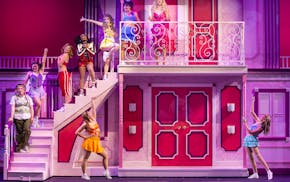Curious Minnesotans, this weekend is for you.
Doors Open Minneapolis is a free event that runs Saturday and Sunday and lets you poke your head into a diverse array of old and new buildings in Minneapolis. Produced by Rethos, a Minnesota-based historic preservation nonprofit, it's the fourth year for the event.
The lineup is not just for architecture buffs. And it's not just about how a city looks, but what it does.
"It's got a little bit of something for everyone," said Heidi Swank, executive director of Rethos. "There's a Sherlock Holmes sitting room in the Elmer Andersen Library, and we have the Lift Garage, a nonprofit that helps people who can't afford the whole price of car repair. Anyone can walk into the Rand Tower now, but with Doors Open you actually get a tour — you're not just wandering around, there's the story told to you."
So, what's new this year that we shouldn't miss?
"Mayor [Jacob] Frey said they have renovations at City Hall to show us, [and they will include] some of the historic features people will see for the first time," Swank said.
With 75 locations opening their doors, it can be hard to pick a favorite. Swank had some suggestions.
"The manhole cover on Nicollet Mall [at 555 Nicollet]. It's so, so surprising. I love the way of making our city work entertaining, something right under your feet. You've walked over that cover a bajillion times, having no idea what happens underneath it," Swank said. "They put a camera down there and show you the sewer systems and how the city operates. You don't have to get down there — they have really huge screens so everyone can see how it works."
Swank hopes to include the U.S. Bank Stadium for the next Doors Open. For now, though, there are enough venues to keep you busy this weekend. If you're absolutely unsure where to go, here are a few ideas.
Strangest building
The Ivy Tower (201 S. 11th St.) was the Christian Science Tower from 1930 to 1965. The church was converted into offices when the building became the Ivy. When you visit, take a good look at the older structure enveloped by the modern tower, and imagine three more, just like it. The original plan had four towers with a church in the middle, but the stock market crash of 1929 put an end to that. The style was unique for the time — a strange mishmash of pseudo-Mesopotamian architecture, with an exterior cladding of aggregate rock. It's not a lovable building, but it's unique.
Best place for Hollywood glamour
Fhima's Minneapolis (40 S. 7th St.) is a perfectly preserved 1930s cafeteria, the likes of which can scarcely be found in the country, let alone Minnesota. The upscale French-Moroccan restaurant was once the famed Forum Cafeteria, a bustling spot where office workers and shoppers could eat for cheap in a silvery mirrored setting and get the experience of a Hollywood nightclub, complete with moderne chandeliers.
Best place to imagine how you'd furnish it
Hennepin History Museum (2303 3rd Av. S.) was a private dwelling once. It's a strange and chilly place for a family to live, and has a tragic story. It was commissioned by a milling company executive, George Christian, but he died before it was finished. As did his wife and his son. The property went to Christian's daughter-in-law, who lived in the dream home for 36 years. By all accounts she was a lively lady who loved to dance around the living room with her dog, so imagine that as you tour the rooms.
Best place to pretend it's 1963
The Iconic Dome at the Sheraton (1313 Nicollet Mall) was a symbol of Minneapolis downtown renewal when it went up as the Capp Towers Motor Hotel in 1963. Made with Plexiglas, the dome was 50 feet in diameter and 22 feet high and served as a music venue at the top of the 15-story building. The indoor rooftop dining under a Buckminster-Fuller-type dome is very "Mad Men"-like.
Most astonishing art
From the smallest grave marker to the most ornate memorial, every plot in Lakewood Cemetery (3600 Hennepin Av. S.) has a story connected to Minneapolis history. Among the hidden gems is the Memorial Chapel, designed by local architect Harry Wild Jones. It's a miniature Hagia Sofia, the great Byzantine church in Istanbul, hewn from St. Cloud granite. New York designer Thomas Lamb crafted the astonishing interior, where a mosaic of 10 million marble pieces glitters above and around.
Best unlikely history lesson
Much of the Rand Tower (527 Marquette Av. S.) is covered in Art Deco ornamentation with an aviation theme. And that's for a good reason. Its developer, Rufus Rand, was a gas-company scion and World War I aviation hero. Hence the flight motifs on the building's bas-reliefs. It's a beautiful structure that rivals the serene behemoths of New York's best late-1920s skyscrapers, and it has a particular connection to Minneapolis architectural history. Leroy Buffington was a local 19th-century architect who patented the iron-frame method of skyscraper construction in 1888, and patiently awaited the steady stream of royalty payments. They never came. He sued, often; he lost, always. Rand paid Buffington $2,500 in royalties when he built the tower, an act of generosity that must have made Buffington feel vindicated.
The optical illusion building
The Canopy Hotel (708 S. 3rd St.) presents a conundrum. Does it have six stories, or seven? It turns out, both. It was originally the Advance Thresher and Emerson-Newton Implement Co. buildings, and was constructed in two phases. The first had seven stories; the second was the same height, but had five. You might never have noticed, but once you see it, you'll always see it.
Doors Open Minneapolis
When: 10 a.m.-5 p.m. Sat. & Sun.
Where: 75 venues across Minneapolis.
Info: Free; doorsopenminneapolis.org.

For 'Legally Blonde' star, 'being underestimated is her secret superpower'

Restaurant openings and closings in the Twin Cities

Minnesota's Amy Thielen launches old-fashioned radio show for food lovers
Yuen: How success has pushed Minnesotans off sidelines in trans athlete debate

